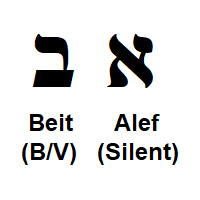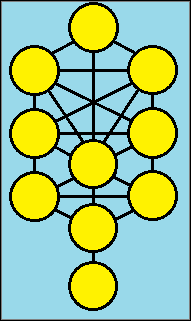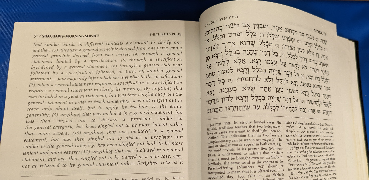Level: Basic
The word "Torah" is a tricky one, because it can mean different things in different contexts. In its most limited sense, "Torah" refers to the Five Books of Moses: Genesis, Exodus, Leviticus, Numbers and Deuteronomy. But the word "torah" can also be used to refer to the entire Jewish bible (the body of scripture known to non-Jews as the Old Testament and to Jews as the Tanakh or Written Torah), or in its broadest sense, to the whole body of Jewish law and teachings.
To Jews, there is no "Old Testament." The books that Christians call the New Testament are not part of Jewish scripture. The so-called Old Testament is known to us as Written Torah or the Tanakh.
This is a list of the books of Written Torah, in the order in which they appear in Jewish translations, with the Hebrew name of the book, a translation of the Hebrew name (where it is not the same as the English name), and English names of the books (where it is not the same as the Hebrew name). The Hebrew names of the first five books are derived from the first distinctive word or phrase of the book. For example, the book known in English as Numbers is known in Hebrew as Bamidbar (In the wilderness...), which is actually the fifth word of the book, but the first four words are "And G-d spoke to Moses", a phrase that occurs a truly staggering number of times in the Bible. The text of each book is more or less the same in Jewish translations as what you see in Christian bibles, although there are some occasional, slight differences in the numbering of verses and there are some significant differences in the translations.
TORAH (The Law):
NEVI'IM (The Prophets):
KETUVIM (The Writings):
Written Torah is often referred to as the Tanakh, which is an acrostic of Torah, Nevi'im and Ketuvim.
The scriptures that we use in services are written on parchment scrolls. They are always hand-written, in attractive Hebrew calligraphy with "crowns" (crows-foot-like marks coming up from the upper points) on many of the letters. This style of writing is known as STA"M (an abbreviation for "Sifrei Torah, Tefillin and Mezuzot," which is where you will see that style of writing). For more information about the STA"M alphabet, including illustrations and relevant rules, see Hebrew Alphabet used in writing STA"M.
You are not supposed to touch the parchment on these scrolls; some say because they are too holy; some say because the parchment, made from animal skins, is a source of ritual defilement; others say because your fingers' sweat has acids that will damage the parchment over time. Instead, you follow the text with a pointer, called a Yad. "Yad" means "hand" in Hebrew, and the pointer usually is in the shape of a hand with a pointing index finger (I always find this incredibly amusing). The scrolls are kept covered with fabric, and often ornamented with silver crowns on the handles of the scrolls and a silver breastplate on the front.
The scrolls are kept in a cabinet in the synagogue called an "ark," as in Ark of the Covenant, not as in Noah's Ark. The words are different and unrelated in Hebrew. Noah's ark (and also the ark that Moses was placed in) are called in Hebrew teyvat (ship). I was taught that the "Ark" of the Covenant and the ark in synagogue are an acrostic of "aron kodesh" (holy cabinet, the Hebrew name for the place where the scrolls are kept), but others have told me that it is merely an archaic English word derived from the Latin arca (cabinet), which is a translation of the Hebrew word aron.
The Torah scrolls that we read from in synagogue are unpointed text, with no vowels or musical notes, so the ability to read a passage from a scroll is a valuable skill, and usually requires substantial advance preparation (reviewing the passage in a text with points). See Hebrew Alphabet for more on pointed and unpointed texts. They also have no verse numbers, no chapter numbers, and not even anything to identify the specific book! It can be very challenging to find the right place, especially since over a hundred verses begin, "And G-d spoke to Moses saying..." or "And G-d said to Moses..."
Most synagogues have several Torah scrolls in the ark. It's a good idea to have at least three, because there are days when the Torah reading, a key part of the morning service, includes pieces from three different places. For example, if the first day of the month of Nissan (the month with Passover) falls on Shabbat, we read from the regular weekly portion (varies from year to year but usually from Leviticus), a special piece for the first of the month (Numbers 28:9-15) and a special piece for the beginning of the month of Nissan (Exodus 12:1-20). You really don't want to spend time scrolling to each of those locations in the middle of a service, so three different scrolls are positioned during the week before it and all three are taken out during the service. This does not happen very often, and I don't think there are any services that have four separate readings. It is convenient to have additional scrolls because holidays usually have readings from two places and they are not the same on both days of a two-day holiday. If the holiday falls back-to-back with Shabbat, that's an additional reading or two to prepare for. It's a good idea to have enough scrolls to get everything set up in advance instead of having to sort things out during Shabbat or the holiday. Most of the time, though, the regular weekly Torah reading comes from one location.
Jewish scriptures are sometimes bound in a form that corresponds to the division into weekly readings (called parshiyot in Hebrew; the singular is parshah). Scriptures bound in this way are generally referred to as a chumash. The word "chumash" comes from the Hebrew word meaning five, and refers to the five books of the Torah. Sometimes, a chumash is just a collection of the five books of the Torah, but usually a chumash contains the five books, divided up by the weekly parshiyot, with the haftarah portion for each week inserted after each week's parshah.
In addition to the written scriptures we have an "Oral Torah," a tradition explaining what the above scriptures mean and how to interpret them and apply the Laws. Orthodox Jews believe G-d taught the Oral Torah to Moses, and that knowledge was passed on to others, down to the present day. This tradition was maintained only in oral form until about the 2d century C.E., when the oral law was compiled and written down in a document called the Mishnah.
Over the next few centuries, additional commentaries elaborating on the Mishnah were written down in Jerusalem and Babylon. These additional commentaries are known as the Gemara. The Gemara and the Mishnah together are known as the Talmud. This was completed in the 5th century C.E.
There are actually two Talmuds: the Jerusalem Talmud and the Babylonian Talmud. The Babylonian Talmud is more comprehensive, and is the one most people mean if they just say "the Talmud" without specifying which one.
There have been additional commentaries on the Talmud by such noted Jewish scholars as Rashi and Rambam. Adin Steinsaltz completed a new edition of the Talmud in 2010, with his own commentary supplementing the Mishnah, Gemara, and Rashi commentaries.
The Talmud is not easy to read. It reminds me of someone else's class notes for a college lecture you never attended. There are often gaps in the reasoning where it is assumed that you already know what they are talking about, and concepts are often expressed in a sort of shorthand. Biblical verses that support a teaching are often referenced by only two or three words. (translations often fill in the gaps, sometimes boldfacing the actual words in the source). The Talmud preserves a variety of views on every issue, and does not always clearly identify which view is the accepted one.
The Mishnah is divided into six sections called sedarim (in English, orders, related to the words seder and siddur). Each order contains one or more divisions called masekhtot (in English, tractates). There are 63 masekhtot in the Mishnah. Approximately half of these masekhtot have been addressed in the Talmud. Although these divisions seem to indicate subject matter, it is important to note that the Mishnah and the Talmud engage in quite a bit of free-association, thus widely diverse subjects may be discussed in an order or a tractate. Below is the division of the Mishnah into sedarim and masekhtot:
In recent times, many observant Jews have taken up the practice of studying a page of Talmud every day. This practice, referred to as daf yomi (page of the day), was started at the First International Congress of the Agudath Yisrael World Movement in August, 1923. Rav Meir Shapiro, the rav of Lublin, Poland, proposed uniting people worldwide through the daily study of a page of Talmud. Daf Yomi started its 14th cycle on January 5, 2020. The 15th cycle will begin on June 8, 2027. A calendar of the cycle and other resources can be found at Daf Yomi Calendar. You can see what today's page of Talmud looks like at this Daf Yomi page, That site also has audio discussing today's daf, but it can be difficult for beginners because it is very fast and bounces between Hebrew terminology and English discussion and it assumes you come to the recording with a high level of background knowledge. There are also a variety of Daf Yomi podcasts from a variety of perspectives.
In addition to these works, we have midrashim, which are basically stories expanding on incidents in the Bible to derive principles or Jewish law or to teach moral lessons. For example, there is a midrash about why Moses wasn't a good speaker (he put coals in his mouth as a child basically as a way of proving that he wasn't greedy), and another one about Abram discovering monotheism and rejecting his father's idolatry (that's a nifty one: basically, he smashes up all his father's idols except the big one, then blames the mess on the big one, as a way of showing his father that the idols don't really have any power). Some of them fill in gaps in the narrative. For example, in Gen. 22:2, why does G-d say, "thy son, thine only son, whom thou lovest, even Isaac." Wouldn't the name alone be enough? One story says that the narrative is skipping out Abraham's responses. "Take thy son." "Which one?" "Thine only son." "But I have two!" "Whom thou lovest." "I love them both!" "Even Isaac." (I'm not sure this is a traditional one -- I got it from a questionable source -- but I like it).
There is also a vast body of responsa, answers to specific questions of Jewish law. Beginning in the middle ages, when local rabbis were faced with difficult issues of Jewish law, they often wrote to the most respected rabbis in the world to get answers to these questions. The local rabbi would present the situation, often including detailed references to the Talmudic passages he had reviewed and his own interpretations of these authorities, and the world-renowned rabbi would provide a reasoned argument in favor of his answer. Over time, these responsa were collected into printed volumes. This tradition continues to the present day, and there were several rabbis in the late 20th century who developed responsa on issues relating to modern technologies. For example, Rabbi Moshe Feinstein, who died in the 1980s, wrote responsa on such diverse topics as the permissibility of cosmetic surgery, the kashering of dishwashers, and artificial insemination. There are literally thousands of volumes of responsa. A project at Bar-Ilan University is compiling these responsa into an online database. See their website at The Responsa Project for more information. (you need a subscription or a disk to search it; it's not intended for casual users). There are also responsa from the Conservative and Reform movements of Judaism. A 21st century Reform responsa addressed the question of whether a person who identifies as female but was born male and has male genetalia must have a circumcision as part of her conversion to Judaism. See Circumcision of a Transgender Female.
As you can see, the body of Jewish tradition is very vast. Is there any place to get quick answers? In the middle ages, there were several attempts to create definitive codes of Jewish law. The best-known of these codes are Rambam's Mishneh Torah and Joseph Caro's Shulchan Arukh. In their own time, these works were very controversial, because they did not identify the Torah or Talmudic basis for their opinions and generally ignored conflicting opinions. There was concern that such works would discourage Jews from studying the primary sources: Torah and Talmud. Today, however, these sources are well-respected. In fact, the Shulchan Arukh is often treated as a primary source.
We also have a mystical tradition, known as Kabbalah. The primary written work in the Kabbalistic tradition is the Zohar. Traditionally, rabbis discouraged teaching this material to anyone under the age of 40, because it is too likely to be misinterpreted by anyone without sufficient grounding in the basics.
 Torah Readings
Torah Readings Hebrew Alphabet
Hebrew Alphabet Halakhah: Jewish Law
Halakhah: Jewish Law Kabbalah and Jewish Mysticism
Kabbalah and Jewish Mysticism Recommended Books and Publishers
Recommended Books and Publishers